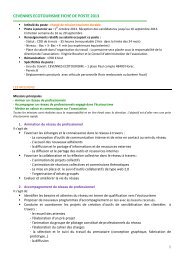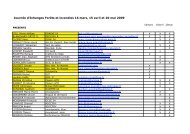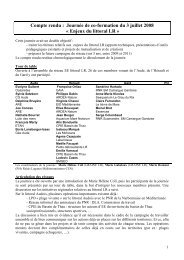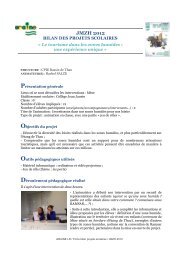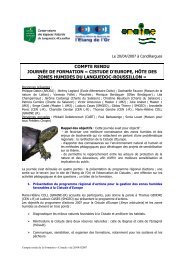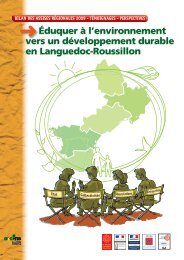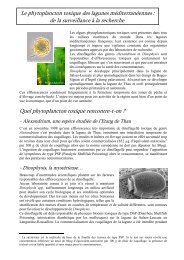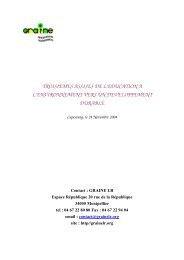Guide de la Diren LR - Le GRAINE LR
Guide de la Diren LR - Le GRAINE LR
Guide de la Diren LR - Le GRAINE LR
Create successful ePaper yourself
Turn your PDF publications into a flip-book with our unique Google optimized e-Paper software.
d’hivernage<br />
VALEUR PATRIMONIALE DE L’ESPECE<br />
Composante Nature Niveau<br />
Valeur<br />
patrimoniale<br />
<strong>de</strong> l’espèce<br />
Statut<br />
européen<br />
Statut<br />
national<br />
Directive Habitats<br />
Convention <strong>de</strong> Berne<br />
Convention <strong>de</strong> Bonn<br />
MNHN (1994)<br />
Annexe II<br />
Annexe II<br />
Annexe II<br />
Vulnérable<br />
Statut<br />
régional<br />
Avis d’expert (GC<strong>LR</strong>)<br />
Vulnérable<br />
Divers<br />
<strong>Le</strong>s popu<strong>la</strong>tions <strong>de</strong> l’arrière pays sont encore assez importantes. Par contre <strong>la</strong> popu<strong>la</strong>tion du littoral est<br />
fortement menacée. Seulement trois colonies <strong>de</strong> reproduction sont connues actuellement entre le Gard et<br />
les Pyrénées-orientales.<br />
MENACES IDENTIFIEES<br />
Menace sur<br />
l’espèce<br />
Menace sur<br />
ses habitats<br />
Dérangement dans les sites <strong>de</strong> reproduction ou disparition pure et simple <strong>de</strong>s gîtes (rénovation du bâti)<br />
Intoxication <strong>de</strong>s chaînes alimentaires par l’emploi <strong>de</strong> pestici<strong>de</strong>s ou <strong>de</strong> vermifuges sur le bétail<br />
Collision routière<br />
Modification <strong>de</strong>s paysages par l’agriculture intensive (arasement <strong>de</strong>s haies, <strong>de</strong>s talus, etc.)<br />
MESURES DE CONSERVATION ENVISAGEES<br />
Maintien d’un paysage et d’une agriculture favorables à l’espèce dans un rayon <strong>de</strong> 2 km autour <strong>de</strong>s colonies<br />
connues, en particulier maintien <strong>de</strong>s haies et <strong>de</strong>s pâtures<br />
Maintien <strong>de</strong>s ripisylves et <strong>de</strong>s boisements <strong>de</strong> feuillus<br />
Mise en tranquillité <strong>de</strong>s gîtes <strong>de</strong> reproduction<br />
Limiter l’emploi <strong>de</strong> vermifuges à base d’ivermectine sur le bétail et remp<strong>la</strong>cer par <strong>de</strong>s produits moins nocifs à base<br />
<strong>de</strong> moxi<strong>de</strong>ctine, fenbendazole ou oxibendazole.<br />
Recherche <strong>de</strong>s gîtes <strong>de</strong> reproduction insuffisamment connus<br />
CODE<br />
ACTION<br />
G2<br />
G12<br />
G23<br />
G21<br />
G36<br />
BIBLIOGRAPHIE<br />
GROUPE CHIROPTÈRES CORSE, 1997.- Chauves-souris <strong>de</strong> <strong>la</strong> directive « Habitats ». Rapport Agence pour <strong>la</strong> gestion <strong>de</strong>s espaces<br />
naturels <strong>de</strong> Corse (AGENC), Bastia, 27 p.<br />
GRÉMILLET X. & coll., 1999.- <strong>Le</strong> Grand Rhinolophe Rhinolophus ferrumequinum (Schreber, 1774). p. : 18-43. In ROUÉ S.Y. &<br />
BARATAUD M. (coord. SFEPM), 1999.- Habitats et activité <strong>de</strong> chasse <strong>de</strong>s chiroptères menacés en Europe :<br />
synthèse <strong>de</strong>s connaissances actuelles en vue d’une gestion conservatrice. <strong>Le</strong> Rhinolophe, numéro spécial, 2 : 136<br />
p.<br />
DUVERGÉ P.L. & JONES G., 1994.- Greater horseshoe bats activity, foraging and habitat use. Bristish Wildlife, 6 : 69-77.<br />
JONES G., DUVERGÉ P.L. & RANSOME R.D., 1995.- Conservation biology of an endangered species: field studies of Greater<br />
horsehoe bat (Rhinolophus ferrumequinum). Symposia of the Zoological Society of London, 67 : 309-324.<br />
MITCHELL-JONES A.M., 1998.- Landscapes for Greather horseshoe bats. ENACT, 6 (4) : 11-13.<br />
RANSOME R.D., 1996.- The management of feeding areas for Greater horseshoe bats. English Nature Research Reports, 174 :<br />
1-74.<br />
RANSOME R.D., 1997. The management of Greater horseshoe bat feeding areas to enhance popu<strong>la</strong>tion levels. English Nature<br />
Research Reports, 241 : 1-63.<br />
RUFRAY V., PRIE V. (à paraître) – Premier comptage simultané <strong>de</strong>s chiroptères hivernants en <strong>LR</strong>- Hiver 2005-2006. Bull. <strong>Le</strong><br />
Vespère.<br />
ROS J., 1999.- <strong>Le</strong> Grand rhinolophe, Rhinolophus ferrumequinum, en France. Bulletin <strong>de</strong> <strong>la</strong> SFEPM, 38 : 29.<br />
Catalogue régional <strong>de</strong>s mesures <strong>de</strong> gestion <strong>de</strong>s habitats et <strong>de</strong>s espèces d’intérêt communautaire – Type <strong>la</strong>gunes littorales. DIREN <strong>LR</strong>.<br />
BIOTOPE, CEN-<strong>LR</strong>, Tour du Va<strong>la</strong>t, Pôle Re<strong>la</strong>is Lagunes méditerranéennes. 2007.<br />
79



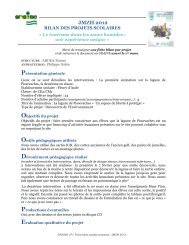
![[PDF] : grainelr.org - Le GRAINE LR](https://img.yumpu.com/43844933/1/184x260/pdf-grainelrorg-le-graine-lr.jpg?quality=85)
